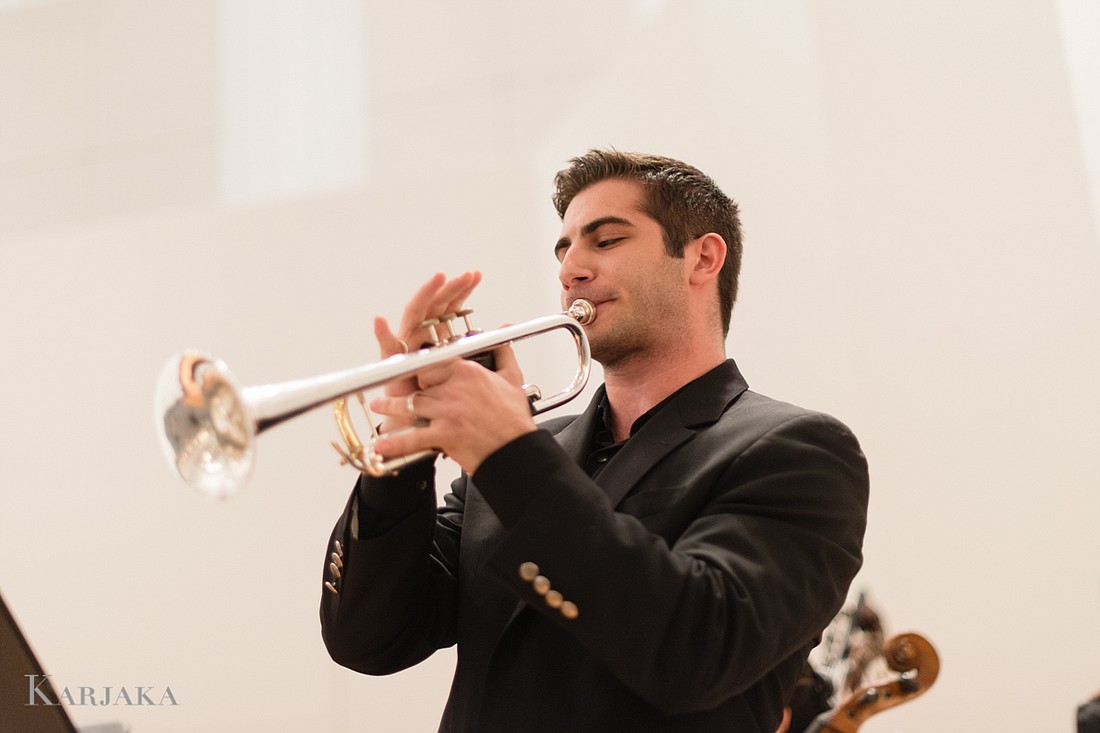- April 23, 2024
-
-
Loading

Loading

It’s hard to believe that ensembleNEWSRQ is in its fourth season of presenting new and current music to Sarasota audiences, but indeed it is, with an evening entitled “Frequent Flyers” on Sept. 30 for a large audience at First Church downtown.
I’ve never really understood where Luciano Berio is going, or coming from for that matter, in his series of “Sequenzas” for solo instruments and voice. He wrote 14 of these pieces, each calling for extended techniques, which usually meant “extended difficulties.” Quite possibly, Berio was primarily interested in finding and developing new sounds from each instrument, which often caused the performer to create a new method of producing these sounds and to sometimes go completely against the norms of instrumental or vocal production.
Having said that, each Sequenza presents a new challenge unique to each instrument. Anthony Limoncelli, newly appointed principal trumpet of the Sarasota Orchestra, was absolutely fearless in his performance of Sequenza X for C trumpet and piano resonance — already something new.
Co-Artistic Director George Nickson sat at the piano and held down notes without sounding them while Limoncelli played blasts (sometimes blats) into the piano, which caused the strings to resonate the preplayed notes. It was a most interesting effect that would have been helped by amplification, but nevertheless Limoncelli provided us with a complete vocabulary of double and triple tonguing, glissandos, half-valve notes and others I couldn’t identify. It was a journey through a kaleidoscope of trumpet sound that makes the words “tour de force” seem almost trivial.
Quite a contrast was Pëteris Vasks’ Wind Quintet No. 1 “Music for Fleeting Birds,” beautifully played by Betsy Hudson Traba, flute; Nicholas Arbolino, oboe; Laura Petty, clarinet; Fernando Traba, bassoon; and Joshua Horne, horn. This is a most evocative piece and so accurately portrays the swarming, swooping, fluttering and even restful sounds of species of birds that I was repeatedly reminded of Alfred Hitchcock.
With Magnus Lindberg’s “Ottoni,” the concert really got down to serious business. Originally written for the powerhouse brass section of the Chicago Symphony, Ottoni featured hornists Joshua Horne, Priscilla Rinehart, Feliks Gmitruk and Andrew Karr; trumpets Sam Jones, Federico Montes, Anthony Limoncelli, and Dan Kasteen; trombones Brad Williams, Steven Osborne and Marc Morgan; and tubist Aaron Tindall — all conducted by George Nickson.
Although the composer has given us an intellectual description of the work, what we as first-time listeners heard was a chordal exploration of the many colors created by the various brass groups. Some of the chordal moments were pretty “far out,” reminiscent of some of the sounds written by Russo and Greaettinger for the Stan Kenton orchestra of the 1950s, but more sophisticated in their resolution. Interesting that a brass ensemble is capable of such varied tone colors, but Lindberg found them, and this group of players performed all with excellent intonation and ensemble.
Ottoni isn’t really a melodic work, but we still heard some romantic sounds, and a friend commented that it reminded her of the sounds of outer space but more friendly.
The final work was “Couleurs de la Cité Céleste” of Olivier Messiaen, a major undertaking for any group. Somehow I think that ensembleNEWSRQ has been working toward this since its very first concert four years ago.
It is in many ways a culmination of ambition and musicianship. Messiaen called for every musical “couleur” possible, painting in vast brush strokes of organized cacophony, followed by quiet introspective passages symbolizing the “Celestial City” and “The One” who inhabits it. It was almost an aural overload presenting us with so much color and contrast, both in scoring and volume, that we were all a bit taken back. The percussion, using so many sounds of Asian gamelan, with chimes and charms, only served to propel our musical visions forward.
Using a group of 20 players — clarinets, trumpets, horns and trombones, aided by some six percussionists, all ably conducted by Nickson — this was clearly the most ambitious effort yet of this collective of outstanding musicians. Guest artist and pianist Conor Hanick artfully contributed Messiaen’s piano colorings to the spectrum of sound.
I must say a word about Nickson’s conducting ability. He seems to have a natural talent for decoding these complicated scores of contemporary music and leading his colleagues clearly through the thickets. I, for one, certainly believe that in not too many years he will need to face a decision between being an expert percussionist and a blooming conductor. Yes, I mean that, so keep watch.
The audience was treated to an encore, composed by and in honor of Christopher Rouse, a leading composer who had just recently died. It was his “Ogun Badaris” for five percussionists, based on Haitian Voodoo rituals. This music, with is constant galloping rhythm, reminded me so much of “Uranus, the Magician” from “The Planets” of Holst but with a lot of modern bumps and twists. We all loved it, and it was really an appropriate ending for an intriguing evening of music for everyone.